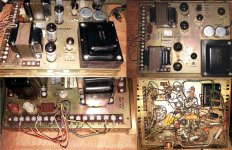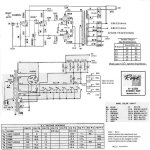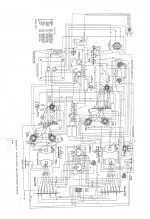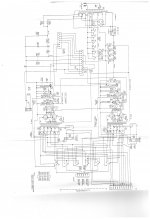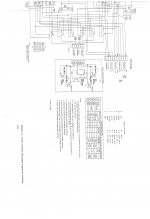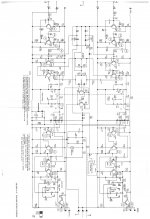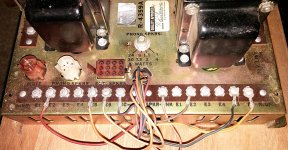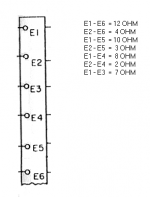Hi all.
I just picked one of these up for cheap. Anybody familiar with this amp? I looked over a few posts but no real info I could use. I haven't tried to power it up yet. I found a schematic but it doesn't show any of the socket-ed inserts ( i.e... Volume, Mute, Phono Speakers, and external speakers).
I'm assuming I wouldn't be so lucky as to not need to use any of these to complete the circuit. Ultimately, I'd like to use it "as is" as a stereo power amp. I'm not trying to convert it into a guitar amp or anything. Here's some pics. Let me know what you think!
Thanks in advance!
I just picked one of these up for cheap. Anybody familiar with this amp? I looked over a few posts but no real info I could use. I haven't tried to power it up yet. I found a schematic but it doesn't show any of the socket-ed inserts ( i.e... Volume, Mute, Phono Speakers, and external speakers).
I'm assuming I wouldn't be so lucky as to not need to use any of these to complete the circuit. Ultimately, I'd like to use it "as is" as a stereo power amp. I'm not trying to convert it into a guitar amp or anything. Here's some pics. Let me know what you think!
Thanks in advance!

Attachments
I know this amp. For half a year I repaired it. This amp comes out of a jukebox.
There is a separate preamp that gets ita power out of this amp.
I must have the complete diagram's I will look to them and post them.
There is a separate preamp that gets ita power out of this amp.
I must have the complete diagram's I will look to them and post them.
I know this amp. For half a year I repaired it. This amp comes out of a jukebox.
There is a separate preamp that gets ita power out of this amp.
I must have the complete diagram's I will look to them and post them.
Thanks for the reply!
I appreciate any help. Yeah I see that it provides power for a pre-amp. However, is it necessary "in circuit" to run the power section? That also goes for the other plug-able sockets as well, minus the rca inputs of course. It's also not very clear on how to hook up speakers.
Thanks again!
Is that their schematic, or is that something you cut and pasted? Many jukebox amps do require other things to be connected, but the jacks and connections for those things are always on the schematic. So with that premise, I see nothing on this schematic showing a need for other parts to be connected.
Speakers? You won't likely need the 70v winding, so leave those screws empty. The main outs are multiple transformer taps, so the amp can be connected to a wide variety of loads. Jukeboxes have their own internal speakers, but are also usually connected to external speakers as well. 70v systems are for distributing sound to a bunch of speakers, like say 20 of them scattered around a restaurant. If you use low impedance external speakers and the box internals, then you need to account for the total load impedance. The operating manual for the box had speaker wiring charts for using all those taps. There would also usually be a card inside the box.
This partial schematic fro Audiokarma forum shows typical in box speaker wiring. The screw terminals are still available for external connections, but the juke power level selector switch is shown. This should be similar to yours
http://www.verntisdale.com/schem/jbm-200b.jpg
Speakers? You won't likely need the 70v winding, so leave those screws empty. The main outs are multiple transformer taps, so the amp can be connected to a wide variety of loads. Jukeboxes have their own internal speakers, but are also usually connected to external speakers as well. 70v systems are for distributing sound to a bunch of speakers, like say 20 of them scattered around a restaurant. If you use low impedance external speakers and the box internals, then you need to account for the total load impedance. The operating manual for the box had speaker wiring charts for using all those taps. There would also usually be a card inside the box.
This partial schematic fro Audiokarma forum shows typical in box speaker wiring. The screw terminals are still available for external connections, but the juke power level selector switch is shown. This should be similar to yours
http://www.verntisdale.com/schem/jbm-200b.jpg
Is that their schematic, or is that something you cut and pasted?
It's the result of a Google image search for "R-4359A schematic".
Speakers? You won't likely need the 70v winding, so leave those screws empty. The main outs are multiple transformer taps, so the amp can be connected to a wide variety of loads. Jukeboxes have their own internal speakers, but are also usually connected to external speakers as well. 70v systems are for distributing sound to a bunch of speakers, like say 20 of them scattered around a restaurant. If you use low impedance external speakers and the box internals, then you need to account for the total load impedance. The operating manual for the box had speaker wiring charts for using all those taps. There would also usually be a card inside the box.
Right. I can go ahead and miss the 70v implementation.
This partial schematic fro Audiokarma forum shows typical in box speaker wiring. The screw terminals are still available for external connections, but the juke power level selector switch is shown. This should be similar to yours
http://www.verntisdale.com/schem/jbm-200b.jpg
Looks like it gives you some crossover points off the terminal.
Thanks for the info 🙂
Last edited:
Hi,
I found the schema's, I hope they will help you repearing the amp. They did to me. 🙂
Thanks a million!

I'm still a bit confused with the whole terminal. It just seems unnecessary. If you were to just hook up a pair of speakers (left and right, not frequency separated by the amp), where would be the best place? 5,6,7,8 off the EXT speakers mate-n-lok socket?
Attachments
That ought to work.
Jukeboxes rarely just sit there making pretty music, they work for a living in commercial applications. The seemingly pointless terminals are there to make the thing versatile. There are many options for connecting speakers to it. The speakers in the jukebox have their options, and the use of external speakers has options. Combinations of both are common. 70v terminals are added for multispeaker installations like restaurants. Balancing the sound around a venue is important. One example I like to use is having all the ceiling speakers set up for 5 watts or 2.5 watts maybe, except the speaker near the waitress station might be set for only 1 watt or 0.5 watt, so they can hear their orders. A lot of boxes are set up with ONLY external speakers, the box itself stays silent, to prevent a hot spot in front of it.
Jukeboxes rarely just sit there making pretty music, they work for a living in commercial applications. The seemingly pointless terminals are there to make the thing versatile. There are many options for connecting speakers to it. The speakers in the jukebox have their options, and the use of external speakers has options. Combinations of both are common. 70v terminals are added for multispeaker installations like restaurants. Balancing the sound around a venue is important. One example I like to use is having all the ceiling speakers set up for 5 watts or 2.5 watts maybe, except the speaker near the waitress station might be set for only 1 watt or 0.5 watt, so they can hear their orders. A lot of boxes are set up with ONLY external speakers, the box itself stays silent, to prevent a hot spot in front of it.
Each amp has its own speaker output in the screw terminal near the output transformer. This is also wired to the connection for the internal speakers combination of the jukebox.
If you don't have the jukebox you don't need this connection and make a new one for yourselves.
The left and the right speakeroutput is the the 6 screw terminals near eacht outputtransfomer.
4 ohm is connection 6 and 2
8 ohm is connection 1 and 4
other impedanties are available and if you want to know them I can tell you.
If you don't have the jukebox you don't need this connection and make a new one for yourselves.
The left and the right speakeroutput is the the 6 screw terminals near eacht outputtransfomer.
4 ohm is connection 6 and 2
8 ohm is connection 1 and 4
other impedanties are available and if you want to know them I can tell you.
Thank you guys for the info!
OK, this would be a huge favor. Using this as a template, could you (in your photo editor) write under each terminal pin what ohms it corresponds to?
If you have a min to do this, it would be greatly appreciated.
Thanks again!
Rob
OK, this would be a huge favor. Using this as a template, could you (in your photo editor) write under each terminal pin what ohms it corresponds to?
If you have a min to do this, it would be greatly appreciated.
Thanks again!
Rob
Attachments
Thanks man!
On more question,
Do/Should I just take all existing terminal connections off? It's so cluttered it's flustering me. I have a few other tube amps but they are very straight forward.
On more question,
Do/Should I just take all existing terminal connections off? It's so cluttered it's flustering me. I have a few other tube amps but they are very straight forward.
OK, so I turned it on for the first time with the 8 ohm connections. It is working but there is a ground hum. It's also lighting up my protection light bulb a little bit but over time, not right away. Could that be a tube?
Thanks all for the help!
Rob
Thanks all for the help!
Rob
This is weird. both channels work but only 2 of the 4 tubes are glowing. Now if it weren't for this partial short :/
Hi,
Yes, you need to disconnect the existing wires. These wires are for the internal luodspeakers in the jukebox its selves.
Then this amp is straight forward again.
Yes, you need to disconnect the existing wires. These wires are for the internal luodspeakers in the jukebox its selves.
Then this amp is straight forward again.
There should 7 tubes glowing. Which tubes are "off".
That youre protection light is on is normal (100 watt bulb ?) that its light is delayed could come from warming up the other tubes. Hum can come from unbalanced output tubes.
In the netherlands we say " Meten is weten 🙂 ". When you measure then you know.
That youre protection light is on is normal (100 watt bulb ?) that its light is delayed could come from warming up the other tubes. Hum can come from unbalanced output tubes.
In the netherlands we say " Meten is weten 🙂 ". When you measure then you know.
- Home
- Amplifiers
- Tubes / Valves
- Rowe R-4359A Amplifier
